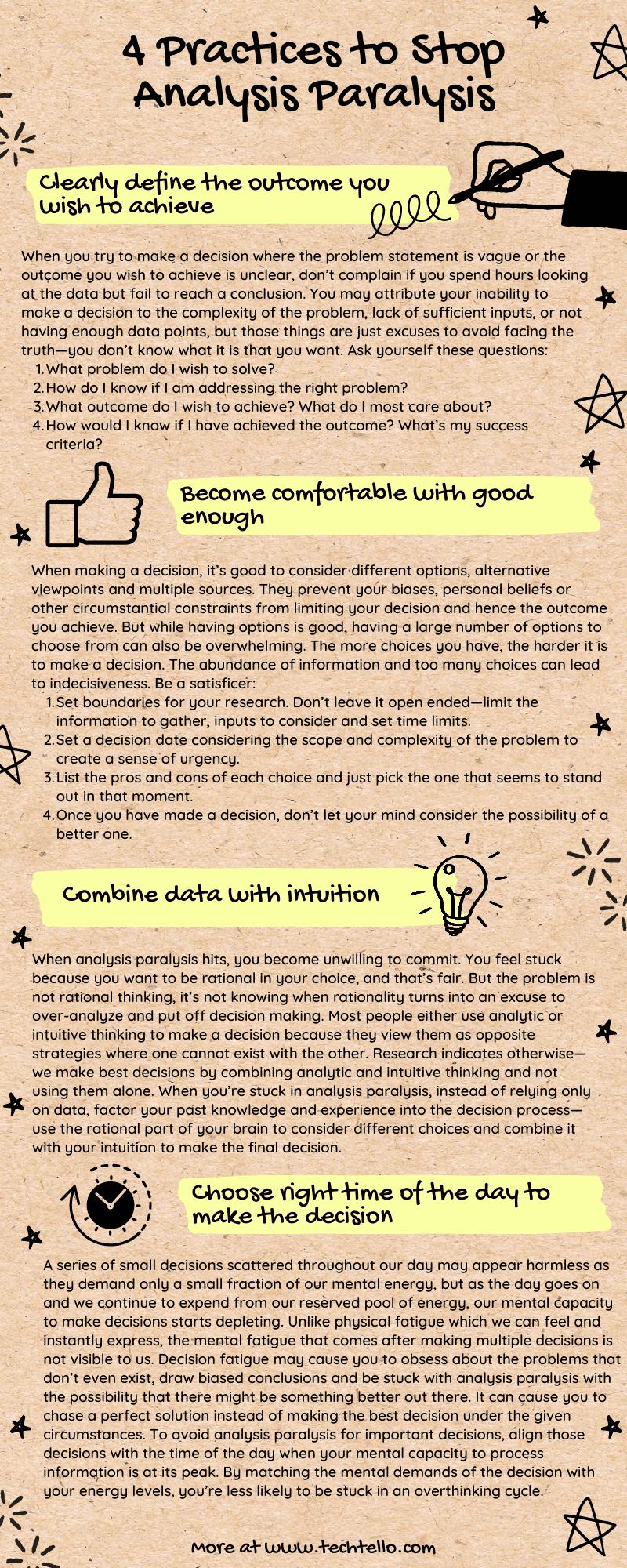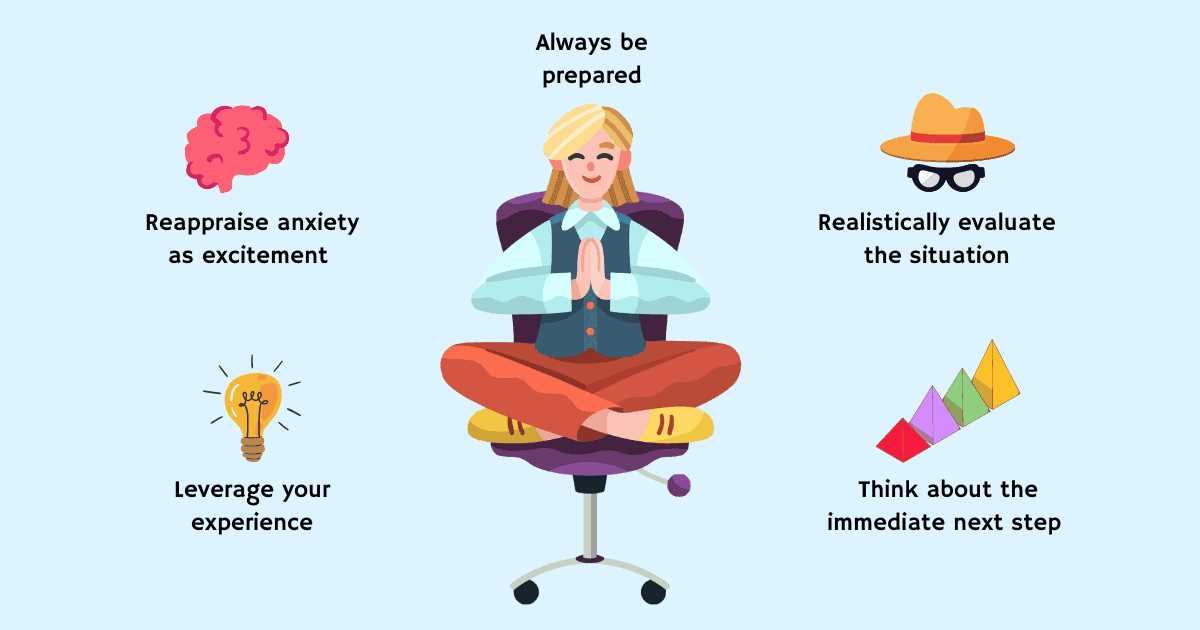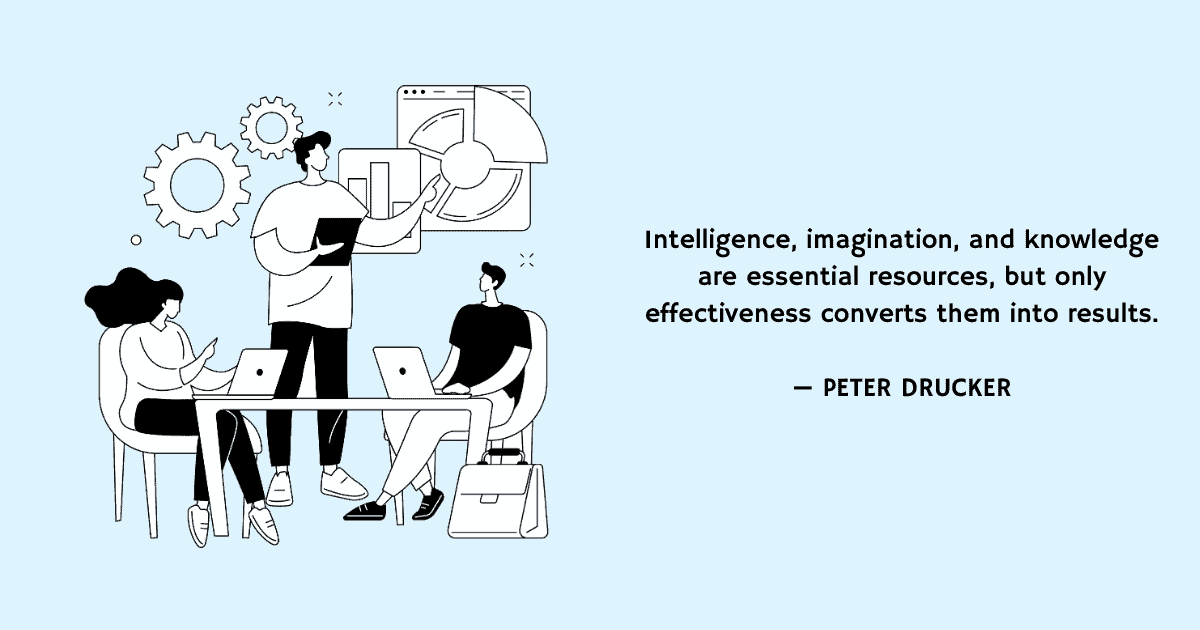How to Stop Analysis Paralysis and Make More Confident Decisions
Theodore Roosevelt once said “In any moment of decision, the best thing you can do is the right thing. The worst thing you can do is nothing.”
When making important decisions with possible life altering effects, the uncertainty of the outcome and the fear of stepping into the unknown keeps us locked in an unproductive cycle where the more data we collect and the more we analyze it, the more we overthink our decision.
Our imagination runs wild—we assume the worst possible scenario and consider it as our best case. We create stories in our mind and reject all good options with the possibility of a better option out there.
For example: decision to relocate, quitting your job to start a business, switching careers, rolling out a major shift in a company’s strategy etc.
Call it fear, perfectionism, laziness or lack of focus, spending all your time analyzing while failing to act leads to analysis paralysis. Desire to make the perfect decision turns into indecision. You struggle to reach a conclusion because you keep chasing certainty which does not exist—no one can know with surety if a particular decision is the best or will lead to the desired result.
Thinking too much leads to paralysis by analysis. It’s important to think things through, but many use thinking as a means of avoiding action.
— Robert Herjavec, The Will To Win
You can never make perfect decisions, but you can certainly make more confident decisions by using these 4 practices:
Clearly define the outcome you wish to achieve
When you try to make a decision where the problem statement is vague or the outcome you wish to achieve is unclear, don’t complain if you spend hours looking at the data but fail to reach a conclusion.
You may attribute your inability to make a decision to the complexity of the problem, lack of sufficient inputs, or not having enough data points, but those things are just excuses to avoid facing the truth—you don’t know what it is that you want.
Bringing clarity to the problem and defining the success criteria is the first half of the challenge. It’s the stepping stone to a successful decision. Without it, any effort you put into the second half is useless.
To do this, ask yourself these questions:
- What problem do I wish to solve?
- How do I know if I am addressing the right problem?
- What outcome do I wish to achieve? What do I most care about?
- How would I know if I have achieved the outcome? What’s my success criteria?
Analysis paralysis also happens when your success criteria is impossible to meet—you expect everything on your list with a 100% guarantee and are unwilling to compromise on anything.
Good success criteria is not a wish list. It involves identifying one most crucial thing you care about—your North Star. Knowing your North Star simplifies the decision process—just find an option that looks promising and has a good probability of achieving it.
Defining the problem statement clearly and the outcomes you wish to achieve will help you stay focused and ease out the decision making process.
Amazing Goal Planner
Become your best self by setting and achieving goals in all important areas of your life.
Become comfortable with good enough
When making a decision, it’s good to consider different options, alternative viewpoints and multiple sources. They prevent your biases, personal beliefs or other circumstantial constraints from limiting your decision and hence the outcome you achieve.
But while having options is good, having a large number of options to choose from can also be overwhelming. The more choices you have, the harder it is to make a decision. The abundance of information and too many choices can lead to indecisiveness.
You may end up spending a lot of time researching solutions, fixate on the shortcoming of each one and continue investing time and energy with the hope to find the best option. But instead of making a decision and moving on, choice overload will make you feel more and more unsure.
Choice overload causes us to delay decisions because too many options drain our cognitive systems making us more prone to putting off the decision entirely.
Research also shows that more options can lead to decreased satisfaction and lower confidence in our choice making it more likely that we regret our decisions later.
Psychologist Barry Schwartz says that there are 2 types of people—maximizers and satisficers. Maximizers strive to make a choice that will give them the maximum benefit. They seek and accept only the best. They can’t choose unless they have deeply examined every option which leads to non stop information seeking and social comparison. Satisficers on the other hand use a more modest criteria and choose an option that passes the threshold of acceptability.
To satisfice is to settle for something that is good enough and not worry about the possibility that there might be something better.
— Barry Schwartz, The Paradox of Choice
In order to avoid analysis paralysis, be a satisficer. To do this:
- Set boundaries for your research. Don’t leave it open ended—limit the information to gather, inputs to consider and set time limits.
- Don’t leave the decision date unassigned. Set a date considering the scope and complexity of the problem to create a sense of urgency.
- List the pros and cons of each choice and just pick the one that seems to stand out in that moment.
- Once you have made a decision, don’t let your mind consider the possibility of a better one. Stop second guessing and get down to putting your decision into action.
Being comfortable with good enough isn’t about accepting mediocrity. It still requires making a conscious, thoughtful choice but to do so within boundaries and putting your time and energy into taking action instead of lamenting about the possibility of a better option out there.
Cognitive Distortions Bundle
Challenge and replace irrational thoughts with more realistic and adaptive thoughts.
Combine data with intuition
When analysis paralysis hits, you become unwilling to commit. You feel stuck because you want to be rational in your choice, and that’s fair. But the problem is not rational thinking, it’s not knowing when rationality turns into an excuse to over-analyze and put off decision making.
Rational approach involves deliberate thinking—invoking the slow part of our brain to weigh in different options, comparing trade offs and then making a choice. Intuitive thinking involves emotions, experience and knowledge. Intuitive thinking is neither illogical or irrational, it’s intelligence that you have developed over a lifetime.
Your brain is a pattern matching machine and intuitive thinking relies on matching your current situation to your past patterns to make a decision. That’s why intuition can be sometimes right and sometimes flawed.
Daniel Kahneman, psychologist and economist notable for his work on the psychology of judgment and decision-making, as well as behavioral economics, says that intuition works under 3 conditions:
- There has to be some regularity for you to spot trends or patterns. Intuition can’t be developed or applied to complex systems that are prone to change quickly.
- You must have a lot of experience and practice in the area for you to trust your gut. Without it, if you use your intuition and all goes well, it’s your luck, not your intuition that got you the results.
- You get immediate and concrete feedback on whether you got it right or wrong.
If any of these things are not true, it’s best to think through the problem more rationally.
Most people either use analytic or intuitive thinking to make a decision because they view them as opposite strategies where one cannot exist with the other. Research indicates otherwise—we make best decisions by combining analytic and intuitive thinking and not using them alone.
A purely intuitive strategy relying only on pattern matching would be too risky because sometimes the pattern matching generates flawed options. A completely deliberative and analytic strategy would be too slow.
— Gary Klein
When you’re stuck in analysis paralysis, instead of relying only on data, factor your past knowledge and experience into the decision process—use the rational part of your brain to consider different choices and combine it with your intuition to make the final decision.
Mind Map Templates
Work through complex problems, identify correlations, and see the big picture using these mind map worksheets.
Choose right time of the day to make the decision
A series of small decisions scattered throughout our day may appear harmless as they demand only a small fraction of our mental energy, but as the day goes on and we continue to expend from our reserved pool of energy, our mental capacity to make decisions starts depleting.
Unlike physical fatigue which we can feel and instantly express, the mental fatigue that comes after making multiple decisions is not visible to us.
Decision fatigue as psychologists like to call it leads to poor quality of decision making—we show reluctance to make trade-offs, fall back to easy choices and may even find it difficult to exercise self-control after making a series of decisions.
“If your work requires you to make hard decisions all day long, at some point you’re going to be depleted and start looking for ways to conserve energy. You’ll look for excuses to avoid or postpone decisions. You’ll look for the easiest and safest option, which often is to stick with the status quo,” says Roy Baumeister in Willpower.
Making a good decision requires bringing knowledge from several domains, stitching distinct ideas together, maintaining the right balance of exploring breadth and depth across these ideas, making new connections and then zeroing in on a few candidates that look promising.
When your mental machinery is tired, it’s hard to separate noise from signal. It leads to overthinking—tendency to think too much and move back and forth on ideas without the ability to give them a specific direction.
Decision fatigue may cause you to obsess about the problems that don’t even exist, draw biased conclusions and be stuck with analysis paralysis with the possibility that there might be something better out there. It can cause you to chase a perfect solution instead of making the best decision under the given circumstances.
To avoid analysis paralysis for important decisions, align those decisions with the time of the day when your mental capacity to process information is at its peak. By matching the mental demands of the decision with your energy levels, you’re less likely to be stuck in an overthinking cycle.
Ask yourself these questions before deciding:
- Is it the best time of the day to make this decision?
- Do I feel at my best when making this decision?
- Does everything around me feel more intense than normal?
Schedule a slot on the calendar for the time of the day when you’ll be at your best to make the decision. Once it shows up, align your brain with your goal by telling it to make the decision without further delay.
It may seem like a silly thing to do at first, but by actually repeating it, you can train your brain to make the decision and not overthink it.
Ending with this thought from Terry Goodkind, Wizard’s First Rule that gets me out of paralysis by analysis every single time:
Sometimes, making the wrong choice is better than making no choice. You have the courage to go forward, that is rare. A person who stands at the fork, unable to pick, will never get anywhere.
Stop thinking and act now.
Summary
- Important decisions shouldn’t be postponed, but that is exactly what we do. Desire to make the perfect decision turns into indecision as analysis paralysis prevents us from taking action and moving forward.
- Not clearly defining the problem statement or what you hope to achieve is one of the biggest reasons behind analysis paralysis. When you’re struggling to make a decision, ensure problem clarity and well-defined success criteria.
- Instead of being a maximizer who seeks only the best, be a satisficer—identify an option that’s good enough and stop worrying about the rest.
- Analysis paralysis hits us when we place too much focus on rational thinking while ignoring our intuition. Combining the two together is a great strategy to break the overthinking cycle and take positive action.
- Our tired mind under the effect of decision fatigue turns unwilling to commit. To counter its effect, make decisions during the time of the day when your mental energy is at its peak.






























